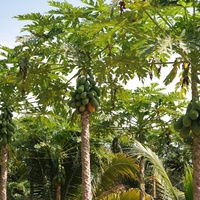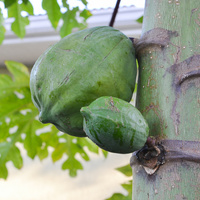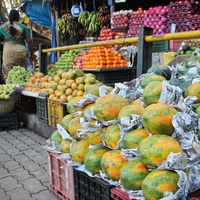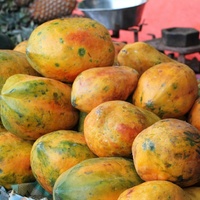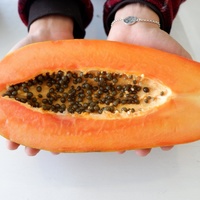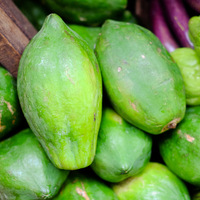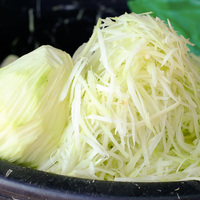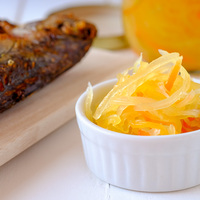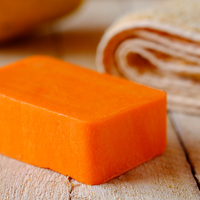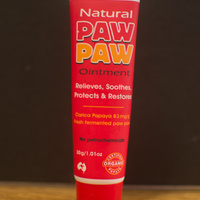Common name: Papaya
Other common names: Paw paw
Description
Originating from Central America, with a natural range extending from Mexico to Panama, the Papaya is nowadays cultivated worldwide for its fruit. Although mostly eaten ripe, it is also used green in salads and chutneys in Southeast Asia.
Papaya is botanically a large herb lacking woody stems. Instead, it develops an upright, unbranched semi-woody trunk with a hollow centre. Growing up to 8 m (26 ft) tall, though much shorter in the cooler parts of its range, the trunk is green when young, grey-brown when mature, smooth (except for leaf scars), and has a compact crown of large leaves at the top. On wounding, it exudes a sticky white latex, as do all plant parts, including the green, unripe fruit.
The leaves are up to 60 cm (2 ft) long, almost as wide, deeply lobed, dull dark green on top, pale green underneath and attach to the trunk with a long, hollow leaf stalk. Arranged along the top of the trunk, they remain on the plant for four to six months, then die back and fall to the ground.
The flowers are tube-shaped when formed, opening into five waxy-white petals. They are either male or female, borne on the same plant or on separate plants, though some varieties come with perfect flowers (having both male and female parts). On plants bearing only male flowers, the flowers are in pendant clusters up to 1.5 m (5 ft) long. On all other plants, they arise solitary or in twos or threes at the leaf axis. They bloom without seasonal influence about four to six months after planting.
Fertilised flowers develop into fruit that are either roundish, pear-shaped, oval or elongated-oval, depending on the type and variety. They can range greatly in size and weight, in length from 15 to 50 cm (6 to 20 in) and in weight from 0.5 kg to 7 kg (1 to 15 lbs) or more, and have thin skin that is dull dark green when young, becoming orange-yellow when ripe. They ripen in progression from the lowest fruit on the trunk to those higher up and are harvested when the skin is half green and half orange-yellow.
After harvest, the fruit are usually stored for a few days to ripen fully. Over time, the skin where green becomes orange-yellow and the fruit, when fully ripe, becomes soft to the touch, which signals its readiness for eating. The thin skin is easily peeled off, revealing soft, aromatic, almost buttery-textured orange-yellow to deep-orange pulp. At the centre of the fruit is a hollow cavity studded with small, round, brown-black seed.
There are many Papaya varieties, differing in plant size, fruit shape, fruit size, pulp colour, flavour and degree of sweetness.
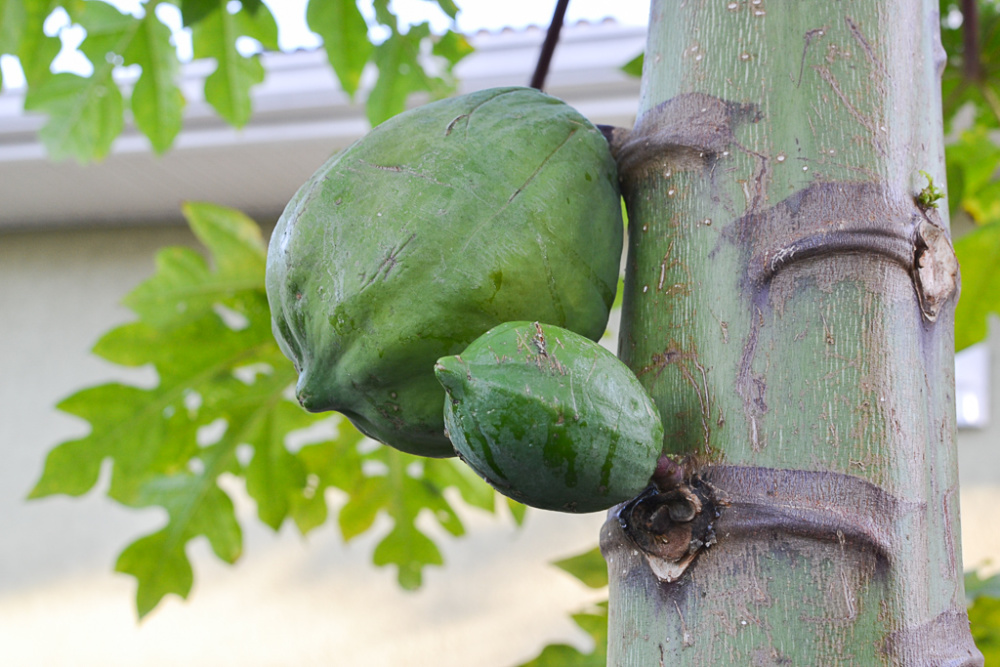
Use
To prepare the ripe fruit the skin is peeled and discarded, the seed removed and the soft pulp sliced or cubed. It is commonly eaten by itself or incorporated in fruit salads and desserts. In some regions, a fine grating of nutmeg (Myristica fragrans) or squeeze of lime (Citrus aurantiifolia) juice is added to complement the flavour, which is sweet and aromatic. Alternately, the whole fruit is cut in half with the skin left on and the pulp, after scooping out the seed, is eaten using a spoon.
In Thailand and Vietnam, the green fruit are made into a popular salad known (unsurprisingly) as green papaya or green pawpaw salad. To make the salad, firm, fully-formed green fruit are peeled and the pulp finely shredded into long, thin strips. The strips are then combined with chilli peppers, tomatoes, string beans, garlic and dried shrimp, usually by pounding them in a mortar pestle. The pounded ingredients are dressed with a mixture containing lime juice, fish sauce and palm sugar and topped with crushed peanuts.
Papain, a commercially important enzyme valued by the food, pharmaceutical and textile industries, is obtained from the latex. It has protein-digesting action and is used as a meat tenderiser, a clarifying agent to remove the protein haze in beer (and other bottled beverages) and to break down gluten protein in baked goods. Papain is also used in medicines and ointments to promote wound healing and in textiles for de-gumming silk.
Papain is harvested only from the green fruit while they are still on the plant, which involves wounding them with shallow, longitudinal incisions and then collecting the latex as it drips and falls. This is done early in the morning when the yields and enzyme activity are at their highest. New incisions are made every three to five days, as long as the fruit remains green.
After it is collected, the latex is spread thinly on trays, then allowed to dry in the sun or in a dryer, until the moisture level reduces to 5 to 8%. At the same time, care is taken to ensure the drying temperature does not exceed 40°C (104°F), as this will reduce the enzyme activity. Once dried, papain has a shelf-life of many months. It is an off-white to greyish powder with a fine granular texture similar to semolina. It readily absorbs moisture, so needs to be stored in a moisture-proof environment.
Papaya plants yield on average 140 to 225 grams (5 to 8 ounces) of dried papain per year, which equates to roughly 168 kg per hectare (150 lbs per acre).
The leaves and young fruit also contain fair amounts of papain and are also used to tenderise meat. Wrapping tough pieces of meat in the leaves for a few hours before cooking greatly reduces the toughness, as does adding the fruit to stews and casseroles. Only very young fruit are used, too young to have any seed, and generally only one fruit is needed per pot. Cut into halves or quarters, the pieces are added skin-on to the pot at the start of the cooking process.
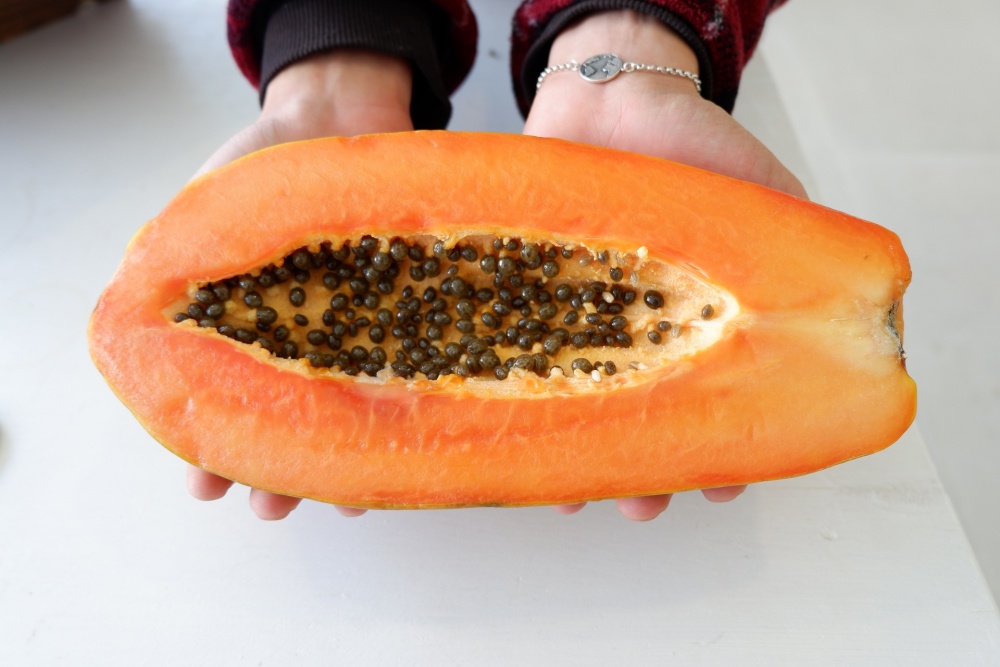
Image by Saray Villar from Pixabay
Health use
Ripe papaya pulp contains high levels of Vitamins A, B1 (Thiamine), B2 (Riboflavin), B3 (Niacin) and C (Ascorbic acid), as well as calcium.
The ripe pulp is also considered an aid to digestion, on account of its papain content. Papain being a digestive enzyme able to break-down the proteins in foods. For this reason, it is sometimes referred to as vegetable pepsin. It is used in chewing gum, as well as in preparing food for invalids, convalescents and young children.
Climate
Papaya grows naturally and produces sweet, flavoursome fruit in humid subtropical and tropical climates, generally frost-free areas with annual lows of 12 to 26°C, annual highs of 22 to 35°C, annual rainfall of 1200 to 3500 mm and a dry season of 5 months or less, extending to 12 months with irrigation.
In the cooler parts of its climate range, papaya plants benefit from being planted next to a winter sun-facing wall, so that the wall will radiate heat, especially over the coldest days and nights. Without enough warmth, the plant may fail to flower and fruit, produce tasteless fruit, or become diseased and die, particularly from root rot, which it succumbs to in cold, wet soil. This practice is recommended for areas where the average low of the coldest month is below 10°C (50°F).
Growing
New plants can be started from seed or cuttings. However, the risk of using seed is that cross-pollination may have occurred, and the desired characteristics may not have been passed on from the parent plant. For this reason, it is best to source seed only from hermaphrodite plants that have self-pollinated or that have been pollinated by another hermaphrodite plant.
Seedlings reproduced from hermaphrodite plants usually results in about two-thirds of the seedlings being hermaphrodite and one-third being female. By contrast, female-only plants only produce unisex seedlings, normally at a ratio of one male to every female (1:1).
Because papaya plants are normally non-branching, cuttings have to be taken from the main stem or trunk. To obtain cuttings, the trunk on mature plants is divided into slender sections around 30 cm (1 ft) long and 5 cm (2 in) in diameter. These are then dipped in a fungicide bath and the rooting end in a rooting hormone. They are then planted in a free-draining potting mix, where most will strike roots within two to three months.
Performs best on free-draining loam, loamy-sand and sandy-loam soils of a moderately acid to alkaline nature, generally with a pH of 4.5 to 8.0, and on sites with full sun exposure.
Papaya plants start producing harvestable fruit about nine months after planting (though the 'Solo' variety may take up to eighteen months to do so) and continue to produce fruit for up to two years after that. Yields in commercial plantations average around 25,000 kgs per hectare (22,000 lbs per acre) per year, though yields of up to 85,000 kgs per hectare (76,000 lbs per acre) have been reported.
Problem features
Papaya is recorded as having escaped cultivation in Australia, but there does not appear to be any record of it anywhere as a serious weed. It is assessed as a low weed risk species for Hawaii, by the Hawaii Pacific Weed Risk Assessment project (HPWRA).
The latex is extremely irritating to the eyes.
Where it grows
References
Books
-
Adams, C. D. 1972, Flowering plants of Jamaica, University of the West Indies, Mona, Greater Kingston
-
Allen, B. M. 1967, Malayan fruits : an introduction to the cultivated species, Donald Moore Press, Singapore
-
Crane, E., Walker, P. & Day, R. 1984, Directory of important world honey sources, International Bee Research Association, London
-
Dastur, J. F. 1964, Useful plants of India and Pakistan : a popular handbook of trees and plants of industrial, economic, and commercial utility, 2nd ed., D. B. Taraporevala Sons, Bombay
-
Duke, J.A. 1993, CRC Handbook of Alternative Cash Crops, CRC Press, Boca Raton, Florida
-
Editors of Sunset Magazine 2012, The New Western Garden Book: The Ultimate Gardening Guide, 9th edition, Sunset Publishing Corporation, California
-
Fellows, P. 1997, Traditional foods : processing for profit, Intermediate Technology, Technical Centre for Agricultural and Rural Co-operation, London
-
Food and Agriculture Organization of the United Nations (FAO) 1988, Traditional food plants : a resource book for promoting the exploitation and consumption of food plants in arid, semi-arid and sub-humid lands of eastern Africa, Food and Nutrition Paper No. 42, Rome
-
Jamieson, G. S. 1943, Vegetable fats and oils : their chemistry, production, and utilization for edible, medicinal and technical purposes, 2d ed, Reinhold, New York
-
Jensen, M. 1999, Trees commonly cultivated in Southeast Asia : an illustrated field guide, 2nd ed., Food and Agricultural Organisation of the United Nations (FAO) Regional Office for Asia and the Pacific (RAP), Bangkok
-
Khan, I. A. & Abourashed, E. A. 2010, Leung's encyclopedia of common natural ingredients : used in food, drugs and cosmetics, 3rd edition, Wiley Publishing, Hoboken, New Jersey
-
Lorenzi, H. 2006, Brazilian fruits & cultivated exotics (for consuming in natura), Instituto Plantarum de Estudos da Flora, Nova Odessa, San Paulo
-
Macmillan, H. F. 1943, Tropical planting and gardening : with special reference to Ceylon, 5th ed, Macmillan Publishing, London
-
Mollison, B. 1993, The permaculture book of ferment and human nutrition, Tagari Publications, Tyalgum, New South Wales
-
Morton, J. F. & Dowling, C. F. 1987, Fruits of warm climates, Creative Resources Systems, Winterville, North Carolina
-
Parkinson, R. 1999, Culinaria : The Caribbean a culinary discovery, 1st. ed, Koìln: koìnemann, Germany
-
Parrotta, J. A. 2001, Healing plants of peninsular India, CABI Publishing, Wallingford, Oxfordshire
-
Perry, F. & Hay, R. 1982, A field guide to tropical and subtropical plants, Van Nostrand Reinhold Company, New York
-
Queensland Department of Primary Industries and Fisheries (QLD DPI) 2008, Queensland tropical fruit : the healthy flavours of North Queensland, Brisbane
-
Randall, R. P. 2007, The introduced flora of Australia and its weed status, Cooperative Research Centre for Australian Weed Management, Glen Osmond, South Australia
-
Selvam, V. 2007, Trees and shrubs of the Maldives, Food and Agriculture Organisation (FAO) RAP publication (Maldives), Thammada Press Company Ltd., Bangkok
-
Tacon, A. G. & Hasan, M. R. 2009, Feed ingredients and fertilizers for farmed aquatic animals : sources and composition, Food and Agriculture Organization of the United Nations (FAO), Rome
-
Van Wyk, B. E. 2005, Food plants of the world: an illustrated guide, 1st ed., Timber Press, Portland, Oregon
-
Vázquez, Y. C. 1999, Potentially valuable Mexican trees for ecological restoration and reforestation, Institute of Ecology, Database SNIB-REMIB-CONABIO, Project J084, Mexico
Articles, Journals, Reports and Working Papers
-
Hamilton, R.A. 1987, Ten tropical fruits of potential value for crop diversification in Hawaii, Research Extension Series : RES-085, University of Hawaii, Honolulu
-
Percival, S. & Findley, B. 2007 (Reviewed April 2014), What's in Your Tropical Fruit?, Fact Sheet HN 0708, University of Florida IFAS Extension Service, Gainesville, Florida
-
Watson, B.J., & Moncur, M. 1985, Guideline criteria for determining survival, commercial and best mean minimum July temperatures for various tropical fruit in Australia (Southern Hemisphere), Department of Primary Industries Queensland (DPI QLD), Wet Tropics Regional Publication, Queensland
